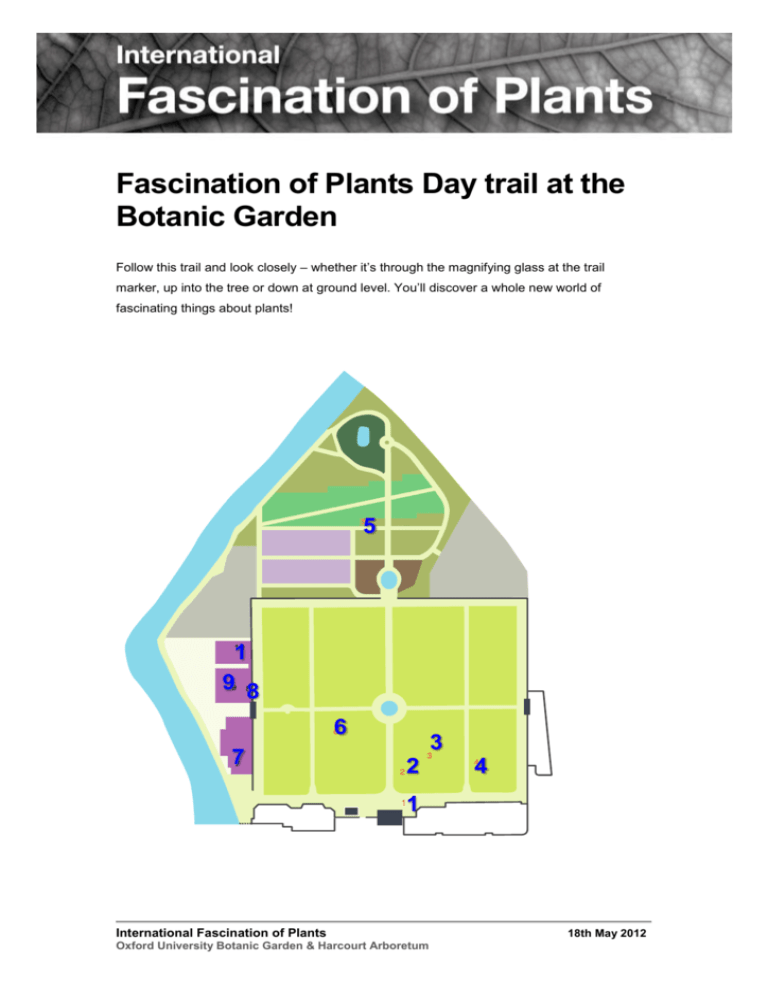Fascination of Plants Day
advertisement

Fascination of Plants Day trail at the Botanic Garden Follow this trail and look closely – whether it’s through the magnifying glass at the trail marker, up into the tree or down at ground level. You’ll discover a whole new world of fascinating things about plants! 5 1 908 6 7 3 2 4 1 International Fascination of Plants Oxford University Botanic Garden & Harcourt Arboretum 18th May 2012 Trail stop 1 Magnolia grandiflora - by the Danby Arch Look underneath the glossy evergreen leaves of this large plant. They are not green but an orange/brown. Look closely through the magnifying glass and you will see that this colour is due to lots of tiny hairs called indumentum. These hairs form a protective coating against water loss and may also contain chemicals that protect against predators. Trail stop 2 Stachys byzantina - Lamiaceae bed Many plants in the mint family have special hairs on the leaves and/or stems. You don’t need to look too closely at the lamb’s ears plant (Stachys byzantina) to see the hairs on the leaves but a close look (with the magnifying glass) at the stems of the rosemary plant (Rosmarinus officinalis) will reveal a special kind of hair. Many mint family plants contain large amounts of special aromatic oils made from terpenes and these are stored in the modified hairs called trichomes. Trail stop 3 Nonea lutea - Boraginaceae bed Plants in this botanical family nearly always are covered in conspicuous stiff hairs. These are unicellular and mounted on a swollen base embedded in the epidermis – the surface of the leaf. Some of the plants in this family may also have cystoliths on the surface of the leaves. These are outgrowths of the cell wall impregnated with silica and/or calcium carbonate (chalk) and help to provide a rough surface to the leaf, making them unpalatable to predators. Feel the leaves and have a closer look with the magnifying glass Trail stop 4 Davidia involucrata – the handkerchief tree Look up high into this tree and see if you can spot the pale green/white “handkerchiefs” hanging amongst the branches. These structures are bracts, which surround each little ball of flowers (inflorescence). They are thought to protect the pollen on the flower from the rain – and a good job too this summer! International Fascination of Plants Oxford University Botanic Garden & Harcourt Arboretum 18th May 2012 Trail stop 5 The Merton borders – Lower Garden Get down as low as you can and take a close look at ground level. Can you see the seedlings emerging from the sand? This large area will soon be a thriving plant community and has been established by sowing seed from over 80 different species of plant. How many different types of seedlings can you spot? This technique is being used to minimise the impact on the environment of establishing a new herbaceous border – minimal water input, minimal air miles to transport plants and minimal use of peat and plastic. Trail stop 6 Euphorbia characias ssp. Wulfenii – Euphorbiaceae bed Take hold of the hand lens on the post by this plant and take a closer look at the unusual flower structure. Euphorbia flowers sit within a structure called the cyathium (from the greek word for a cup or ladle). Around the rim of the cyathium is a ring of swollen appendages, which are glands that secrete nectar in order to attract and reward pollinators. It is these glands that vary so greatly in this euphorbia species. In this sub-species the nectar glands are typically yellow and horned. Trail stop 7 Microsorum punctatum - Fernery The plants in this part of the glasshouses are ferns – non flowering plants. They reproduce via spores and do not produce seeds. Turn over a frond (leaf) and take a look with the hand lens at the structures on the underside. You will find precise and regular patterns of spore bearing structures. These may be spots, stripes or even chain-like arrangements depending on the species. Trail stop 8 Semele androgyna – Lower corridor On your way to the Palm House, stop for a few minutes and take a closer look at this strange plant. Can you see the tiny white flowers? Do they appear to be growing out of a leaf? The “leaf” you see in front of you is in fact a special modified stem called a phylloclade (meaning leaf like branches) and the flowers are growing from nodes on this modified stem. International Fascination of Plants Oxford University Botanic Garden & Harcourt Arboretum 18th May 2012 Trail stop 9 Murraya paniculata – Palm House The shrubby plant on your left as you enter the Palm House belongs to the Citrus family (Rutaceae). One of the botanical characteristics of this family are the special structures on the leaves. Find a new leaf (lighter green colour), tilt it towards the light, and have a close look with the magnifying glass. Can you see the tiny clear windows or dots in the leaf structure? These are called pellucid dots and contain the aromatic oils these plants are well known to contain. Trail stop 10 Pilocereus moritzianus – Arid House This Venezuelan plant is not nearly as fast as its new Formula 1 racing star but it will reveal a secret to you if you look up high. On the side of the plant that faces south (towards the outside of the glasshouse) you will be able to spot some flowers but they are probably closed. This plant blooms at night in the desert and is pollinated by bats and moths that are attracted by the white petals and the musky odour the flower emits. Come in early in the morning on a cloudy day to see the flower open before it closes up after its magical night-time display. International Fascination of Plants Oxford University Botanic Garden & Harcourt Arboretum 18th May 2012








